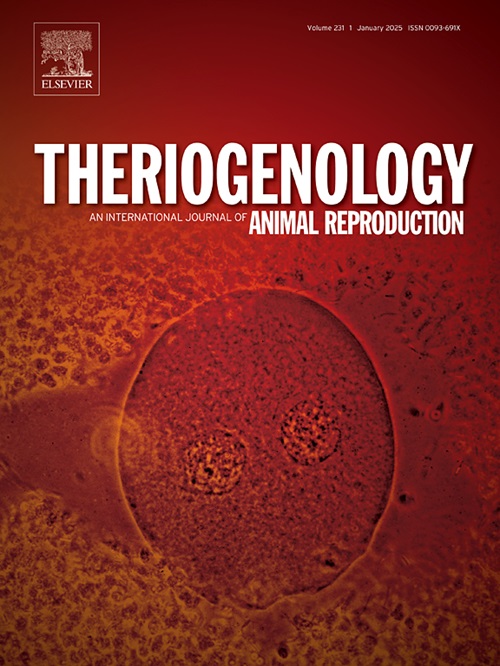Bovine oocyte vitrification and recovery with ethylene glycol and either propylene glycol or dimethyl sulfoxide
IF 2.4
2区 农林科学
Q3 REPRODUCTIVE BIOLOGY
引用次数: 0
Abstract
Cryopreservation of female gametes allows for preservation and transportation of superior genetics; however, cryoinjury and cryoprotectant toxicity often affects the viability of oocytes that do survive the procedure due to the use of suboptimal protocols designed for embryo cryopreservation. With significant differences in cryoprotectant sensitivity and plasma membrane permeability between oocytes and embryos, there is a continued need to develop protocols accounting for the unique physiology of oocytes. In this study, oocyte recovery after vitrification with ethylene glycol and either dimethyl sulfoxide or propylene glycol were evaluated with reduced equilibration time compared to prior studies. In mature oocytes thawed after cryopreservation with the combination of dimethyl sulfoxide and ethylene glycol displayed increased mitochondrial membrane potential and reduced reactive oxygen species compared to those cryopreserved with propylene glycol and ethylene glycol (P < 0.05). The combination of propylene glycol and ethylene glycol only displayed improved recovery of the meiotic spindle measured by microtubule arrangement and chromosome distribution (P < 0.05). There were no differences in adenosine triphosphate (ATP) concentration or the number of ATP-depleted oocytes between those cryopreserved with dimethyl sulfoxide or propylene glycol (P > 0.05). Both mitochondrial and meiotic spindle functionality are vital for embryo development, and the concentration of cryoprotectants required to achieve vitrification affects both aspects of oocyte physiology. Further improvements to oocyte vitrification protocols are necessary to minimize damage induced during the procedure and improve reliability of the technology.
使用乙二醇和丙二醇或二甲亚砜对牛卵母细胞进行玻璃化和复原
低温保存的雌性配子允许保存和运输优越的遗传;然而,冷冻损伤和冷冻保护剂的毒性往往会影响卵母细胞的生存能力,因为使用了不理想的胚胎冷冻保存方案。由于卵母细胞和胚胎在冷冻保护剂敏感性和质膜渗透性方面存在显著差异,因此继续需要制定考虑卵母细胞独特生理的方案。在这项研究中,与之前的研究相比,用乙二醇和二甲亚砜或丙二醇玻璃化后的卵母细胞恢复情况被评估为减少了平衡时间。与丙二醇和乙二醇联合冷冻保存的成熟卵母细胞相比,二甲亚砜和乙二醇联合冷冻保存后解冻的卵母细胞线粒体膜电位增加,活性氧减少(P <;0.05)。丙二醇和乙二醇的组合仅显示出通过微管排列和染色体分布测量的减数分裂纺锤体的恢复(P <;0.05)。二甲基亚砜和丙二醇冷冻保存的卵母细胞在三磷酸腺苷(ATP)浓度和ATP缺失的卵母细胞数量上没有差异。0.05)。线粒体和减数分裂纺锤体功能对胚胎发育都至关重要,实现玻璃化所需的冷冻保护剂浓度会影响卵母细胞生理的两个方面。进一步改进卵母细胞玻璃化工艺是必要的,以尽量减少过程中引起的损伤,提高技术的可靠性。
本文章由计算机程序翻译,如有差异,请以英文原文为准。
求助全文
约1分钟内获得全文
求助全文
来源期刊

Theriogenology
农林科学-生殖生物学
CiteScore
5.50
自引率
14.30%
发文量
387
审稿时长
72 days
期刊介绍:
Theriogenology provides an international forum for researchers, clinicians, and industry professionals in animal reproductive biology. This acclaimed journal publishes articles on a wide range of topics in reproductive and developmental biology, of domestic mammal, avian, and aquatic species as well as wild species which are the object of veterinary care in research or conservation programs.
 求助内容:
求助内容: 应助结果提醒方式:
应助结果提醒方式:


